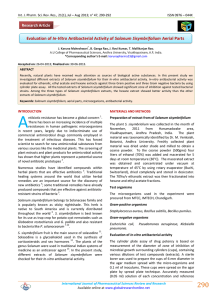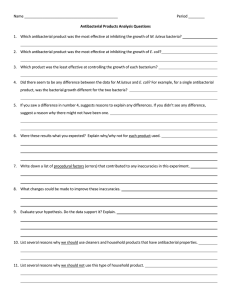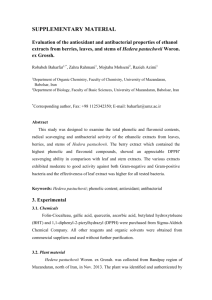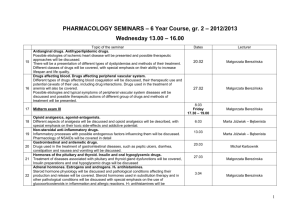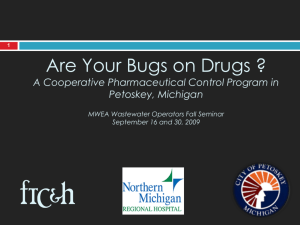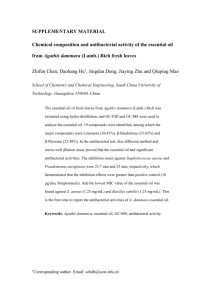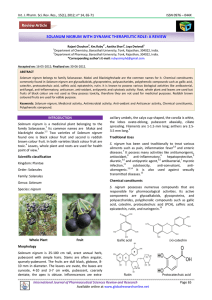Document 13308779
advertisement
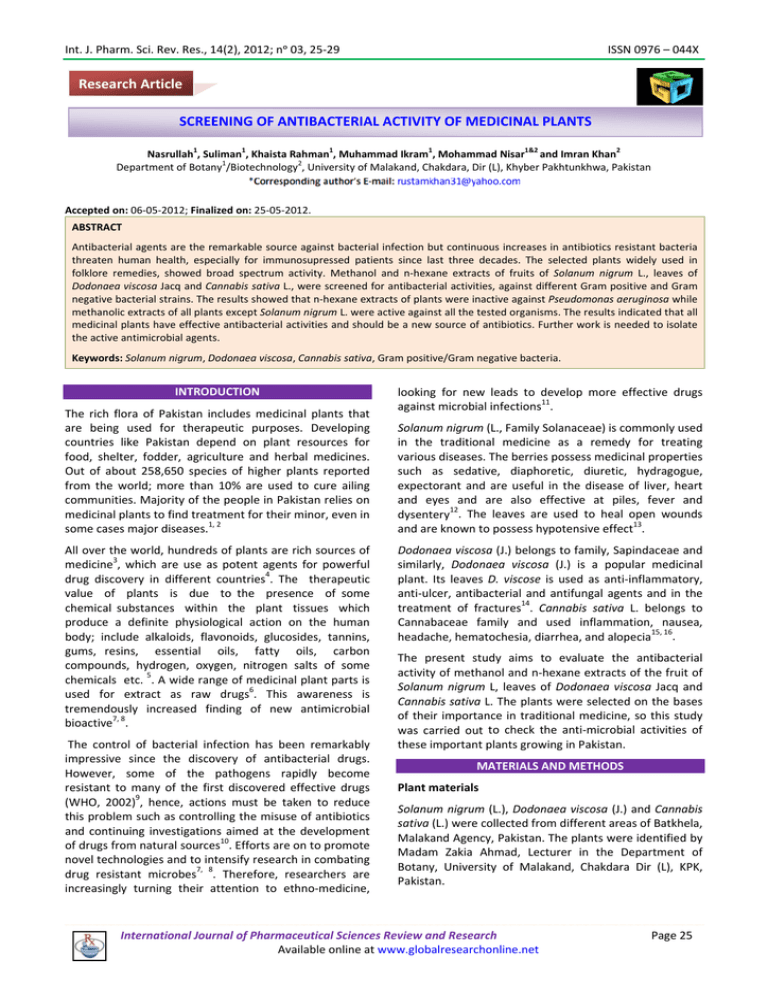
Int. J. Pharm. Sci. Rev. Res., 14(2), 2012; nᵒ 03, 25‐29 ISSN 0976 – 044X Research Article SCREENING OF ANTIBACTERIAL ACTIVITY OF MEDICINAL PLANTS Nasrullah1, Suliman1, Khaista Rahman1, Muhammad Ikram1, Mohammad Nisar1&2 and Imran Khan2 Department of Botany1/Biotechnology2, University of Malakand, Chakdara, Dir (L), Khyber Pakhtunkhwa, Pakistan Accepted on: 06‐05‐2012; Finalized on: 25‐05‐2012. ABSTRACT Antibacterial agents are the remarkable source against bacterial infection but continuous increases in antibiotics resistant bacteria threaten human health, especially for immunosupressed patients since last three decades. The selected plants widely used in folklore remedies, showed broad spectrum activity. Methanol and n‐hexane extracts of fruits of Solanum nigrum L., leaves of Dodonaea viscosa Jacq and Cannabis sativa L., were screened for antibacterial activities, against different Gram positive and Gram negative bacterial strains. The results showed that n‐hexane extracts of plants were inactive against Pseudomonas aeruginosa while methanolic extracts of all plants except Solanum nigrum L. were active against all the tested organisms. The results indicated that all medicinal plants have effective antibacterial activities and should be a new source of antibiotics. Further work is needed to isolate the active antimicrobial agents. Keywords: Solanum nigrum, Dodonaea viscosa, Cannabis sativa, Gram positive/Gram negative bacteria. INTRODUCTION The rich flora of Pakistan includes medicinal plants that are being used for therapeutic purposes. Developing countries like Pakistan depend on plant resources for food, shelter, fodder, agriculture and herbal medicines. Out of about 258,650 species of higher plants reported from the world; more than 10% are used to cure ailing communities. Majority of the people in Pakistan relies on medicinal plants to find treatment for their minor, even in some cases major diseases.1, 2 All over the world, hundreds of plants are rich sources of medicine3, which are use as potent agents for powerful drug discovery in different countries4. The therapeutic value of plants is due to the presence of some chemical substances within the plant tissues which produce a definite physiological action on the human body; include alkaloids, flavonoids, glucosides, tannins, gums, resins, essential oils, fatty oils, carbon compounds, hydrogen, oxygen, nitrogen salts of some chemicals etc. 5. A wide range of medicinal plant parts is used for extract as raw drugs6. This awareness is tremendously increased finding of new antimicrobial bioactive7, 8. The control of bacterial infection has been remarkably impressive since the discovery of antibacterial drugs. However, some of the pathogens rapidly become resistant to many of the first discovered effective drugs (WHO, 2002)9, hence, actions must be taken to reduce this problem such as controlling the misuse of antibiotics and continuing investigations aimed at the development of drugs from natural sources10. Efforts are on to promote novel technologies and to intensify research in combating drug resistant microbes7, 8. Therefore, researchers are increasingly turning their attention to ethno‐medicine, looking for new leads to develop more effective drugs against microbial infections11. Solanum nigrum (L., Family Solanaceae) is commonly used in the traditional medicine as a remedy for treating various diseases. The berries possess medicinal properties such as sedative, diaphoretic, diuretic, hydragogue, expectorant and are useful in the disease of liver, heart and eyes and are also effective at piles, fever and dysentery12. The leaves are used to heal open wounds and are known to possess hypotensive effect13. Dodonaea viscosa (J.) belongs to family, Sapindaceae and similarly, Dodonaea viscosa (J.) is a popular medicinal plant. Its leaves D. viscose is used as anti‐inflammatory, anti‐ulcer, antibacterial and antifungal agents and in the treatment of fractures14. Cannabis sativa L. belongs to Cannabaceae family and used inflammation, nausea, headache, hematochesia, diarrhea, and alopecia15, 16. The present study aims to evaluate the antibacterial activity of methanol and n‐hexane extracts of the fruit of Solanum nigrum L, leaves of Dodonaea viscosa Jacq and Cannabis sativa L. The plants were selected on the bases of their importance in traditional medicine, so this study was carried out to check the anti‐microbial activities of these important plants growing in Pakistan. MATERIALS AND METHODS Plant materials Solanum nigrum (L.), Dodonaea viscosa (J.) and Cannabis sativa (L.) were collected from different areas of Batkhela, Malakand Agency, Pakistan. The plants were identified by Madam Zakia Ahmad, Lecturer in the Department of Botany, University of Malakand, Chakdara Dir (L), KPK, Pakistan. International Journal of Pharmaceutical Sciences Review and Research Page 25 Available online at www.globalresearchonline.net Int. J. Pharm. Sci. Rev. Res., 14(2), 2012; nᵒ 03, 25‐29 ISSN 0976 – 044X Extraction of plant materials Prior extraction, plant parts materials were cleaned 2‐3 times with running water and once with sterilized distilled water then surface sterilized with 1%mercuric chloride. The materials were dried under shade at room temperature (25‐35ᵒC). The air‐dried plant materials were grounded into coarse powder form through electric blender. Three hundred grams of each air‐dried plant material were soaked in 70% methanol and 90% n‐hexane respectively. They were regularly shaken for maximum extraction at 80rpm for seven days. After 7 days, the extract was filtered using Whattman filter paper (No. 1). The extract’s solutions were evaporated to dryness under reduced pressure at temperature of 45°C using a vacuum pump with the rotary evaporator. The paste obtained after rotary evaporation contained some water content which was further dried in water bath at 60C for one hour. The thick pastes obtained are known as the crude extract. The extracts were kept in sterile bottles at 5°C until use. Test microorganisms and microbial culture Five bacterial strains in which two were Gram positive: Bacillus cereus and Bacillus subtilis and three Gram negative: E. coli, Pseudomonas aeruginosa and Salmonella typhi, were used in this study. All the bacterial strains were clinical isolates obtained from the Department of Pharmacy, University of Malakand, Chakdara, Khyber Pukhtunkhwa, Pakistan. Growth media Nutrient agar media is best growth media for bacteria. The Media was composed of Beef extract 3.0g, Agar 15.0g and Peptone 5.0g. One liter media was prepared by dissolving 40g of nutrient agar in 700ml of distilled water. After complete dissolution, the final volume of the media was raised to 1000ml by adding more distilled water. The media was boiled using a hot plate. The PH was adjusted to 7.0 at 25 ºC, using 0.1M NaOH and 0.1M HCl. The needed media and all glassware were sterilized through autoclaving at 15psi at 121 for 20 minutes. culture media using sterile cork borers to make three to five uniform wells in each Petri dish. A drop of molten nutrient agar was used to seal the base of each well. The wells were filled with 50μℓ of the extract concentration of 25mg/ml, 50mg/ml and 100mg/ml. In the central well 50μℓ of 90% n‐hexane and 70% methanol was use as negative control for respective extracts. The antibacterial activities were determined after 24 hours at 37ºC incubation in the incubator. The diameter of zone of inhibition produced by the extract were measured and compared with standard. Each sample was used in triplicate for the determination of antibacterial activity. The work was carried out in laminar flow. RESULTS AND DISCUSSION The methanol and n‐hexane extracts of S. nigrum L. fruits, leaves of D. viscosa Jacq and C. sativa L. were screened for antibacterial activity against two Gram‐positive bacteria; B. subtilis, B. cereus and three Gram‐negative bacteria; E. coli, P. aeruginosa and S. typhi. The methanol crude extracts showed good antibacterial activity than the n‐hexane crude extracts. The n‐hexane extracts of all the tested plants were inactive against P. aeruginosa. The methanol extracts of the plants showed good antibacterial activities. The methanol fruit extract of S. nigrum L. showed significant antibacterial activity against all the tested strains except B. subtilis. The lowest activity was recorded against B. cereus while moderate activity with 16.6 mm ZOI was recorded against S. typhi at 100mg/ml which is in consensus with Rani and Khullar, (2004)20 that S. nigrum L. seeds possess active constituents against S. typhi. Our results showed that the extract has active constituents against other bacterial strains like E. coli and P. aeruginosa with highest ZOI (20mm) at 100 mg/ml. It is shown in table 1 and Fig. 1. Antibacterial activity Antimicrobial was checked by antibacterial susceptibility test (AST). AST standard tests can be conveniently divided into diffusion and dilution methods. Common diffusion tests include agar well diffusion, agar disk diffusion and bio‐autography, while dilution methods include agar dilution and broth micro/macro‐dilution. The broth and agar based methods are the conventional reference methods for AST17. Agar well diffusion assay is used to check crude extract of different plant parts for antibacterial activities18, 19. The 20ml of nutrient agar was plated in Petri dishes and allowed to solidify for 30 minutes. Wells of 6mm in diameter and about 2 cm apart were punctured in the The n‐hexane extract of S. nigrum L. fruit showed good activity against E.coli (14mm) but did not inhibit growth of other strains. This shows that n‐hexane have no ability to extract the active constituent from S. nigrum L. fruit to inhibit B. subtilis, B. cereus, P. aeruginosa and S. typhi. Kaushik et al., (2009)21 report is in divergence with our results who checked ethanol extract of fruit of S. nigrum against S. aureus and B. subtilis, and inhibition was recorded at all the tested concentrations (100, 75, 50 and 25mg/ml). It may be due to ethanol use for extraction by Kaushik et al., (2009)21. Data is shown in Fig. 2. International Journal of Pharmaceutical Sciences Review and Research Page 26 Available online at www.globalresearchonline.net Int. J. Pharm. Sci. Rev. Res., 14(2), 2012; nᵒ 03, 25‐29 ISSN 0976 – 044X Table 1: Antibacterial Activity of Selected Plants Plants Solvents Methanol Solanum nigrum Linn. n‐hexane Methanol Cannabis sativa L. n‐hexane Methanol Dodonaea viscosa Jacq. n‐hexane Concentrations (mg/ml) 25 50 100 25 50 100 25 50 100 25 50 100 25 50 100 25 50 100 Ciprofloxacin (100µg/ml) Diameter of zone of inhibition (mm) B.s B. c E.c P. a S.t ‐ 13±0.1 12.6±0.2 16.1±0.1 10±0.3 ‐ 14.7±0.1 14±0.4 17.2±0.4 15.2±0.3 ‐ 16.3±0.4 20±0.2 20±0.2 16.6±0.2 ‐ ‐ 10±0.1 ‐ ‐ ‐ ‐ 11±0.3 ‐ ‐ ‐ ‐ 14.6±0.5 ‐ ‐ 13.6±0.1 13.1±0.3 11.3±0.2 ‐ 13.5±0.1 19±0.5 15.2±0.2 12±0.1 11.4±0.2 14±0.2 19.3±0.1 16±0.2 23.3±0.2 14.2±0.2 24±0.4 12.5±0.1 ‐ ‐ ‐ ‐ 13.7±0.2 ‐ ‐ ‐ ‐ 15±0.5 11±0.2 10±0.3 ‐ 12.2±0.5 ‐ 10±0.2 11.5±0.1 ‐ 11.8±0.1 ‐ 10.5±0.4 13.6±0.1 14.7±0.5 14.3±0.1 10±0.4 15.4±0.2 18.2±0.2 17.3±0.1 14.6±0.1 ‐ ‐ ‐ ‐ ‐ ‐ 11.1±0.1 12±0.3 ‐ 13.1±0.3 ‐ 13.2±0.1 18±0.1 ‐ 15±0.2 31.1±0.2 26.9±0.2 30.2±0.1 25.1±0.3 28.4±0.1 International Journal of Pharmaceutical Sciences Review and Research Page 27 Available online at www.globalresearchonline.net Int. J. Pharm. Sci. Rev. Res., 14(2), 2012; nᵒ 03, 25‐29 ISSN 0976 – 044X The methanol extract of C. sativa L. leaves was active against all the bacterial strains except P. aeruginosa at 25mg/ml concentration. The extract showed highest activity against all strains which is shown in Fig. 3. The n‐hexane extracts of C. sativa L leaves were active against B. subtilis at all concentrations and showed activity against B. cereus, E. coli and S. typhi at 100mg/ml. P. aeruginosa showed resistance at all concentrations of n‐hexane extract. Wasim et al., (1995)22, published that ethanol and petroleum ether extracts of the leaves of C. sativa L. exhibited activity both against Gram‐positive and Gram‐negative bacteria. B. subtilis showed highest resistance to methanol leaves extract of D. viscosa Jacq. and highest lethality was recorded for E.coli and P. aeruginosa. The n‐hexane extracts (Fig. 4) of D. viscosa Jacq. leaves completely failed against B. subtilis and P. aeruginosa but active against B. cereus, E.coli and S. typhi at 50mg/ml and 100mg/ml concentrations. Previously, Khurram et al., (2009)23 reported that the n‐hexane shoot extracts of D. viscosa Jacq. showed inhibition against E. coli and P. aeruginosa, B. subtilis and S. typhi. Getie et al., (2003)24 also reported that the crude extracts of the leaves of D.viscosa Jacq possess antibacterial activity against Streptococcus pyogenes and staphylococcus aureus. Our results correlated with Thring et al., (2007)25 previously reported that the aqueous, methanol, ethanol and ethyl acetate leaf extracts of D. viscosa Jacq showed activity against P. aeruginosa. The data is showed in Fig. 5 and 6. CONCLUSION The fruit of S. nigrum L, leaves of D. viscosa J. and C. sativa L. showed antibacterial activity. These plants contained active anti‐bacterial constituents. Further work is needed to isolate these active agents which may be use as a good source for antibiotics. Acknowledgment: The authors owe a depth of gratitude to the Department of Pharmacy, University of Malakand, Chakdara, KPK, Pakistan for facilitating the research and also thankful to Madam Zakia Ahmad, Lecturer in the Department of Botany, University of Malakand, Chakdara, KPK, Pakistan for her assistance in identifying plants. REFERENCES 1. Walter C, Shinwari ZK, Afzal I and Malik RN, Antibacterial activity in herbal products used in Pakistan, Pak J Bot 43, (2011), 155‐162. 2. Shinwari ZK, Medicinal plants research in Pakistan, Journal of Medicinal Plants Research 4(3), (2010), 161‐176. 3. Obafemi CA, Akinpelu DA, Taiwo OO, Adeloye A, Antimicrobial activity of solvent extracts of Terminalia catappa linn leaves, Ife J Sci 8(1), (2006), 29‐33. 4. Srivastava J, Lambert J, Vietmeyer N, Medicinal plants: An expanding role in development, World Bank Technical Paper, No. 320, (1996). 5. Sheeba E, Antibacterial Activity of Solanum surattense Burm F, Kathmandu University Journal of Science, Engineering and Technology 6(1), (2010), 1‐4. 6. Uniyal SK, Singh KN, Jamwaland P, Lal B, Traditional use of medicinal plants among the tribal communities of Chhota Bhangal, Western Himalayan, J Ethnobiol Ethnomed 2 (2006), 1‐14. 7. Finch R, Hunter PA, Antibiotic resistance‐action to promote new technologies, J Antimicrob Chemother 58(suppl 1), (2006), 3‐22. 8. Ariyo AO, Antimicrobial activity of the indigenous liverwort, Riccia nigerica Jones, from Southwestern Nigeria, Evansia 28(2), (2011), 43‐48. 9. WHO, Traditional Medicine Strategy 2002‐2005, WHO Publications. 1‐6, (2002). 10. Austan DJ, Kristinsson KG, Anderson RM, The relationship between the volume of antimicrobial consumption in human communities and the frequency of resistance, Tro J Phar. R, 3(2), (1999), 225‐228. 11. Benkeblia N, Antimicrobial activity of essential oil extracts of various onions (Allium cepa) and garlic (Allium sativum), Lebensm‐Wissu‐Technol. 37, (2004), 263‐268. 12. Rastogi, Mehrotra, Compendium of Medicinal Plants, Pakistan Council of Science and Industrial Research, Peshawar, (1991), 134‐135. 13. Ye JR, The hypotensive effect of Solanum nigrum, Zhong Yao Tong Boa 9, (1984), 35‐36. 14. Sama V, Reddy YSR, Ramesh M, Swamy MM, Mahadevan N, Suresh B, Pharmacognostical studies on Dodonaea viscosa leaves, African Journal of Pharmacy and Pharmacology 2, (2008), 83‐88. 15. Xiaozhai L and Clarke RC, The cultivation and use of hemp (Cannabis sativa L.) in ancient China J Int Hemp Assoc 2, (1995), 26‐33. 16. Zias J, Stark H, Sellgman J, Levy R, Werker E, Breuer A, Mechoulam R, Early medical use of cannabis, Nature, 363, (1993), 215. 17. Tenover FC, Swenson JM, Ohara CM, Stocker SA, Ability of Commercial and Reference Antimicrobial Susceptibility Testing methods to detect vancomycin resistance in Enterococci J Clin Microbiol 33(6), (1995), 1524‐1527. 18. Cole MD, Key antifungal, antibacterial and anti‐insect assays‐a critical review, Biochemistry Systemic Ecolology 22, (1994), 837‐856. 19. Okeke MJ, Iroeghu CU, Eze EN, Okoli AS, Esimone CO, Evaluation of extracts of the root of Landolphia owerrience for antibacterial activity, Journal of Ethanopharmacology 78, (2001), 119‐127. 20. Rani P, Khullar N, Antimicrobial evaluation of some medicinal plants for their anti‐enteric potential against multi‐drug resistant Salmonella typhi, Phytotherapy Research 18, (2004), 670‐673. DOI 10.1002/ptr.1522 21. Kaushik D, Jogpal V, Kaushik P, Lal S, Saneja A, Sharma C, Aneja KR, Evaluation of activities of Solanum nigrum L fruit extract, Archives of Applied Science Research 1(1), (2009), 43‐50. International Journal of Pharmaceutical Sciences Review and Research Page 28 Available online at www.globalresearchonline.net Int. J. Pharm. Sci. Rev. Res., 14(2), 2012; nᵒ 03, 25‐29 ISSN 0976 – 044X 22. Wasim K, Haq I, Ashraf M, Antimicrobial studies of the leaf of Cannabis sativa L. Pakistan Journal of Pharmaceutical Sciences 8(1), (1995), 29‐38. 23. Khurram M, Khan MA, Hameed A, Abbas N, Qayum A, Inayat H, Antibacterial Activities of Dodonaea viscosa using Contact Bioautography Technique, Molecules 14, (2009), 1332‐1341. DOI 10.3390/molecules14031332 24. Getie M, Gebre‐Mariam T, Rietz R, Evaluation of the anti‐ microbial and anti‐inflammatory activities of the medicinal plants Dodonaea viscosa, Rumex nervosus and Rumex abyssinicus, Fitoterapia 74(1‐2), (2003), 139‐43. 25. Thring TSA, Springfield EP, Weitz FM, Antimicrobial activities of four plant species from the Southern Overberg region of South Africa, African Journal of Biotechnology 6(15), (2007), 1779‐1784. ********************* International Journal of Pharmaceutical Sciences Review and Research Page 29 Available online at www.globalresearchonline.net
